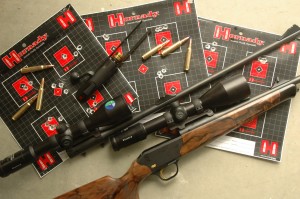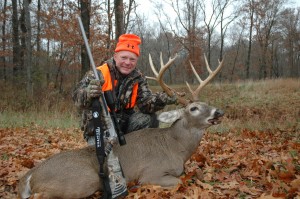
I started hunting in the 1960s. At that time, the telescopic sight was more than a century old, but only fairly recently had come into widespread use. The variable-power scopes we take for granted today were still a bit finicky, so fixed-power scopes were almost universal. The most popular was the fixed 4X, and that was the scope I used clear through the mid-1970s. By then, the variable-power scope had been perfected, and my first 3-9X scope was truly a revelation. Wow! For longer shots, I could turn the power up all the way, and the larger image size made things dramatically easier.
Over time, the 3-9X became America’s most popular rifle scope, and in my opinion remains one of the very best all-around choices for big game hunting. I would say it’s the very best, but it doesn’t stand alone in its class. There are slightly more compact 2.5-8X variables and slightly larger scopes with an upper magnification of 10X. Lump them together, and I think this class of scope remains the most versatile and most useful. The high-end magnification is great for sighting in and shooting groups, and is truly enough magnification for shots at big game at any sensible range. Equally important, the low magnification is low enough that it shouldn’t get you in trouble for close shots in thick cover.
These days, long-range shooting is quite the fad, and variables with considerably more power are becoming increasingly popular. Yes, if you’re really serious about long-range shooting, the increased image size is helpful. The problem is that no matter how much we prepare for the long shot, there are very few situations where close shots aren’t possible. And we need to be prepared for them as well. The most powerful scopes I personally hunt with are in the 4-12X, 4.5-14X, and 4-16X range. For open country situations like sheep and pronghorn hunting, the added magnification lends confidence on longer shots, while the lowest setting is low enough to allow close shooting when necessary.
I genuinely don’t see a need for more powerful scopes for big game hunting. Honestly, under many circumstances mirage and heat waves preclude actually using more magnification, and the availability of the low setting is really important. If an animal pops up unexpectedly at close range, or if you need to follow up a wounded animal in cover, the last thing you want is to throw the rifle up and see just an indistinct blur of hair in your...
scope. In close or mixed cover, it’s a good idea to keep your scope at the lowest setting all the time. In more open country, I tend to hedge my bet, generally keeping the power setting on about 6X. I can always turn up the magnification if I want it for a longer shot.

Despite the great popularity of the medium-range variable scope, it isn’t ideal for all situations. Prices for rifle scopes tend to increase with magnification, as does weight and bulk. If you don’t need the magnification, there’s no sense paying for it or carrying it around! Many of us do our whitetail hunting in situations where shots much past 100 yards are extremely unlikely. And, regardless of terrain and vegetation, literally millions of whitetail hunters are restricted in range by the requirement to use shorter-ranged arms like slug-loaded shotguns and muzzleloaders.
Under such circumstances, the good old fixed 4X scopes I grew up with remain perfectly suitable. Other good choices include the low-range variables from 1-4X on up to perhaps 2-7X. This latter class of scope is also excellent for more specialized short-range hunting such as dangerous game, black bear over bait, any big game hunting with hounds, or still-hunting in thick cover.
Another trend in scopes is toward extra-large objective bells and larger tubes. If quality of lens, coatings, and construction is equal, a larger objective lens will gather more light. The more or less standard objective lens on a 3-9X scope is about 36mm in diameter. A 40mm objective will gather more light, as will 44 and 50mm objectives. Brighter is certainly better, especially if the first and last half-hours of daylight are important in your hunting.
There are, however, some trade-offs. Larger objectives add weight, bulk, and cost to the scope. More serious, at least to me, is that as the objective lens increases in size, the scope must be mounted ever higher in order to clear the barrel. The extra-large objective is very popular in Europe where our concept of legal shooting hours is unknown. Over there, they rarely use lights, but if you can see it you can shoot it. So incredibly bright scopes with objective lenses of 56mm and occasionally more are useful. Unfortunately,...
they must be mounted so high that you may have to lift your head clear off the stock to see through the scope. There are situations here and there where maximum brightness is desirable, but for general use, I prefer to compromise. I generally avoid scopes with objectives larger than 50mm, and I really prefer to keep them down in the low 40s.

Once again, if quality is equal then the European standard 30mm scope tube will gather more light than the American standard one-inch (26mm) tube. The larger tube also allows for a greater range of windage and elevation adjustment. The drawbacks, however, are exactly the same- greater weight and bulk and higher cost. On the other hand, if it’s three minutes before the end of legal shooting time and the buck of a lifetime steps out and stands against darkened woods, you definitely want to be able to see him well enough to place your shot!
Choice of reticles is important, not only for precision long-range shooting but also for snap shots in close cover and a clear sight picture in low light. I will address this subject next month, but for now let’s end this discussion with my thoughts on scope quality.
Choice of reticles is important not only for precision long-range shooting, but also for snap shots in close cover and a clear sight picture in low light. I will address this subject next month, but for now, let’s end this discussion with my thoughts on scope quality. Regardless of the configuration and magnification of the scope you choose, quality is of paramount importance. It is not always necessary to purchase the most expensive premium-quality scope; there are many medium-priced scopes that are truly excellent, and will do everything that most of us need done. However, I do believe that you get what you pay for in sporting optics. Whether it's binoculars, range finders, spottingscopes, or rifle scopes, I recommend purchasing the best scope you can reasonably afford, whatever that means to you. And I’ll go one step further. If you’re on a budget, consider getting a less expensive rifle and topping it with a better scope. Or, carefully evaluate your actual needs, and consider a less powerful...
scope of higher quality.